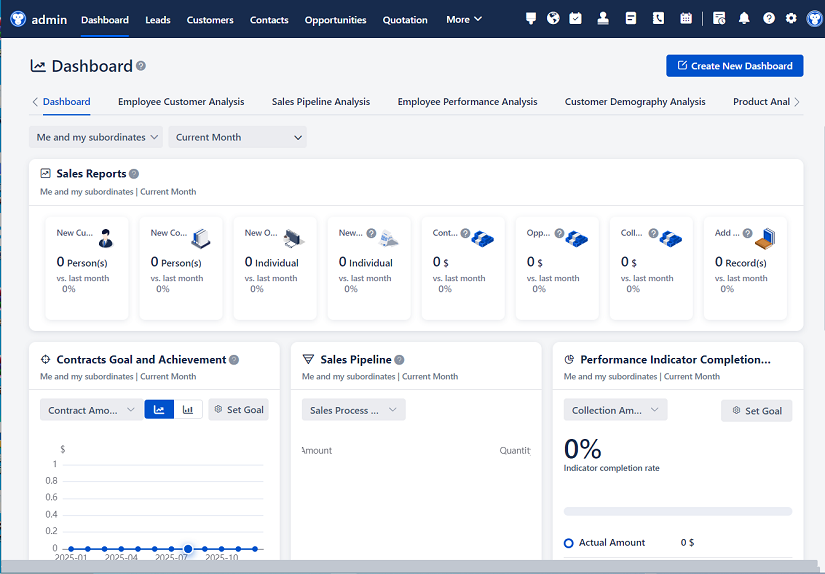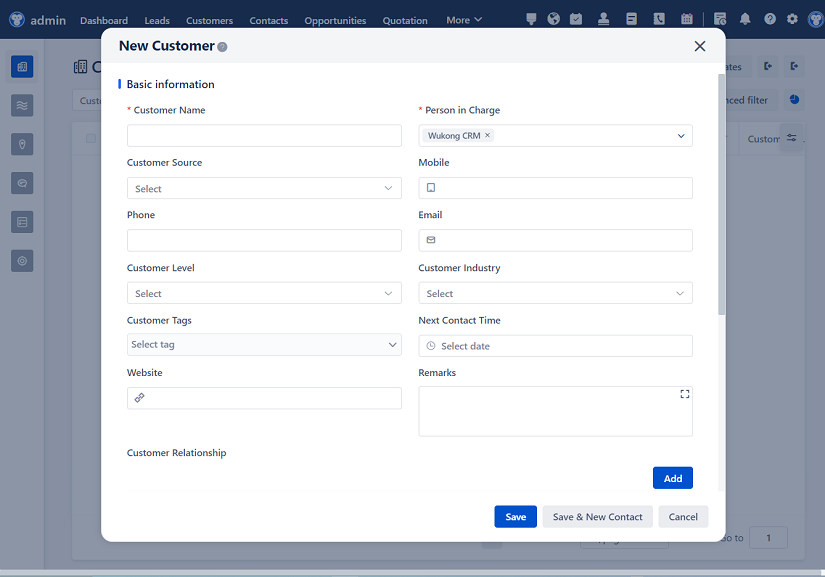
△Click on the top right corner to try Wukong CRM for free
You know, when I first started thinking about how schools and training centers manage their students, staff, and courses, I realized something pretty obvious—there’s a lot going on behind the scenes. I mean, just imagine trying to keep track of hundreds, sometimes thousands, of students, their enrollment status, payment records, course progress, and communication history—all without a solid system in place. It sounds like a nightmare, right? That’s exactly why I started digging into CRM system solutions for the education and training industry. And honestly, what I found completely changed the way I think about how educational institutions operate.
Let me tell you, a CRM—Customer Relationship Management system—isn’t just for sales teams or big corporations. Not at all. In fact, in education, it’s more like a Student Relationship Management tool. Think about it: students are your primary stakeholders. They enroll, they pay, they attend classes, they give feedback, and ideally, they recommend your programs to others. So, managing those relationships effectively? That’s not just helpful—it’s essential.
Free use of CRM system: Free CRM
I remember talking to a friend who runs a small language training center. She was overwhelmed. She had spreadsheets for enrollments, another for payments, a notebook for student feedback, and emails scattered everywhere. She told me, “I spend more time chasing data than actually teaching or growing my business.” That hit me hard. And then I introduced her to a simple CRM built for education. Within weeks, she said she felt like she got her life back. All student info in one place, automated reminders for payments and class schedules, and even follow-ups after course completion. It was a game-changer.
Now, you might be wondering, “Okay, but what exactly can a CRM do for schools or training providers?” Well, let me break it down. First off, it centralizes all student data. No more jumping between five different systems. Everything—contact info, enrollment history, attendance, grades, communication logs—lives in one secure place. And the best part? It’s accessible from anywhere, anytime. That means a teacher, an admin staff member, or even a marketing person can pull up a student’s file with just a few clicks.
And speaking of marketing—this is where CRMs really shine. I’ve seen schools use CRM tools to run targeted email campaigns based on student interests. For example, if someone took a beginner coding course, the system automatically tags them and adds them to a list for intermediate courses. Then, a few weeks later, they get a personalized email: “Hey, now that you’ve mastered the basics, here’s what’s next.” That kind of personalization? It works. Open rates go up, conversions improve, and students feel seen.
But it’s not just about selling more courses. A good CRM helps with student retention, too. Think about it—how many students drop out because they feel disconnected? With automated check-ins, progress reports, and even birthday messages, schools can build stronger emotional connections. I once saw a training institute send a simple “We miss you!” email to a student who hadn’t logged into their online course in two weeks. The student replied, “No one’s ever noticed before. Thanks for caring.” That’s the kind of impact we’re talking about.
On the operational side, CRMs save so much time. Automating routine tasks like sending enrollment confirmations, fee reminders, or certificate deliveries frees up staff to focus on more meaningful work. I’ve heard from school admins who used to spend hours every week just copying and pasting data. Now, with CRM workflows, those tasks happen automatically. It’s like having an extra team member who never sleeps.

And don’t even get me started on reporting. Before using a CRM, many institutions were flying blind. They knew they had students, but they didn’t know which programs were most popular, where dropouts were happening, or which marketing channels brought in the most enrollments. With built-in analytics, schools can now see real-time dashboards showing everything from conversion rates to student satisfaction scores. One university told me they discovered that 70% of their new enrollments came from referrals—so they doubled down on their alumni engagement program. Smart, right?
Another thing I love about education-focused CRMs is how they support blended learning environments. Whether a course is online, in-person, or hybrid, the CRM can track attendance, engagement, and performance across platforms. For example, if a student watches only 30% of their video lectures, the system can flag that and trigger an advisor to reach out. Early intervention like that can make all the difference in student success.
And let’s talk about mobile access. These days, everyone’s on their phones. A good CRM has a mobile app so teachers and admins can update records, send messages, or check schedules while on the go. I’ve seen instructors use it during parent-teacher meetings to pull up a student’s progress instantly. No more fumbling through folders or saying, “I’ll get back to you.” It’s professional, efficient, and impresses parents.
Now, I know what some of you might be thinking: “Isn’t a CRM expensive? Won’t it be hard to set up?” Honestly, that used to be true. But today, there are so many affordable, cloud-based options designed specifically for education. Many offer tiered pricing, free trials, and even nonprofit discounts. And setup? Most vendors provide onboarding support, training, and templates to get you started quickly. I’ve seen schools go live in under two weeks.
Security is another concern people bring up. “What about student data privacy?” Totally valid. But reputable CRM providers comply with regulations like GDPR, FERPA, and COPPA. They use encryption, role-based access, and regular audits to keep data safe. And honestly, a secure CRM is way safer than storing sensitive info in Excel files on someone’s desktop.
One of the coolest features I’ve come across is integration. Modern CRMs can connect with learning management systems (LMS), payment gateways, video conferencing tools, and even accounting software. So when a student enrolls and pays through Stripe, their info automatically flows into the CRM and LMS. No manual entry. No errors. It’s seamless.
I also appreciate how CRMs help with scalability. Whether you’re a small tutoring center or a large university, the system grows with you. Need to add more users? Done. Want to launch a new course series? Easy. The flexibility is incredible. I spoke with a vocational training provider that expanded from one campus to five in three years. Their CRM handled it all without missing a beat.

And let’s not forget about alumni management. A lot of schools lose touch with graduates after they leave. But with a CRM, you can keep alumni engaged—invite them to events, share job opportunities, or ask for testimonials. One college told me their alumni donation rate increased by 40% just by staying in regular contact through their CRM.
Honestly, the more I learn about CRM solutions in education, the more I see them as not just tools, but partners in student success. They help institutions become more organized, more personal, and more effective. And in an industry where relationships matter more than anything, that’s priceless.
So, if you’re part of a school, training center, or educational nonprofit, I really encourage you to explore what a CRM can do for you. Start small. Try a free version. See how it fits your workflow. Talk to other educators who’ve made the switch. You might be surprised at how much smoother everything runs.
At the end of the day, education is about people—students, teachers, parents, staff. And a CRM? It’s not about replacing human connection. It’s about enhancing it. Freeing up time so you can focus on what really matters: teaching, mentoring, and helping learners achieve their goals.
FAQs (Frequently Asked Questions):
Q: Isn’t a CRM just for businesses? Can it really work in education?
A: Absolutely, it can—and it does! While CRMs started in sales, they’ve evolved. In education, they’re used to manage student relationships, streamline admin tasks, and improve communication. Think of it as a smart organizer that helps schools care for students better.

Q: Will my staff need special training to use a CRM?
A: Most modern CRMs are user-friendly and designed with non-tech users in mind. Vendors usually offer training, tutorials, and customer support. Many educators say they’re comfortable using it within a few days.
Q: Can a CRM help with online learning platforms?
Yes, definitely. Many CRMs integrate with popular LMS platforms like Moodle, Canvas, or Teachable. They sync student data, track progress, and even automate course recommendations.
Q: Is my students’ data safe in a CRM?
Reputable CRM providers take data security seriously. They use encryption, secure servers, and comply with privacy laws. Always check the provider’s security policies before signing up.
Q: How much does an education CRM cost?
It varies. Some start as low as
Q: Can a CRM help me get more students?
Yes! With tools for email marketing, lead tracking, and campaign analytics, CRMs help schools attract and convert more applicants. You can target the right audience with personalized messages.
Q: What if I have a small institution? Is a CRM still worth it?
Totally. Even small schools benefit from staying organized, reducing manual work, and building stronger student relationships. Some CRMs are perfect for startups and growing centers.
Q: Can parents access the CRM?
Some CRMs offer parent portals where they can view schedules, payments, and progress reports. It depends on the system, but many include this feature to improve transparency.
Q: Do I need IT support to set up a CRM?
Not necessarily. Cloud-based CRMs are usually plug-and-play. You just sign up, import your data, and start using it. Most providers guide you through setup step by step.
Q: How do I choose the right CRM for my institution?
Start by listing your needs—like enrollment tracking, communication tools, or reporting. Then compare features, pricing, and reviews. Try free demos or trials to see which feels right for your team.
Related links:
Free trial of CRM
Understand CRM software

△Click on the top right corner to try Wukong CRM for free